
Royal Botanic Gardens, Kew, is a non-departmental public body in the United Kingdom sponsored by the Department for Environment, Food and Rural Affairs. An internationally important botanical research and education institution, it employs 1,100 staff. Its board of trustees is chaired by Dame Amelia Fawcett.
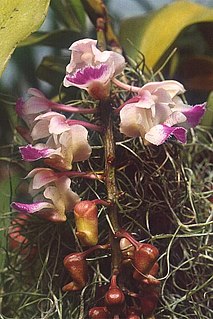
In the botanical classification of plants, Aeridinae is a subtribe of the tribe Vandeae whose representatives all have a monopodial growth habit and do not possess pseudobulbs.
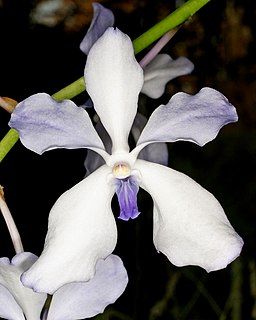
Vanda, abbreviated in the horticultural trade as V., is a genus in the orchid family, Orchidaceae. There are about 80 species, and the genus is commonly cultivated for the marketplace. This genus and its allies are considered to be among the most specifically adapted of all orchids within the Orchidaceae. The genus is highly prized in horticulture for its showy, fragrant, long-lasting, and intensely colorful flowers. Vanda species are widespread across East Asia, Southeast Asia, and New Guinea, with a few species extending into Queensland and some of the islands of the western Pacific.
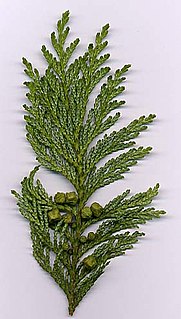
Chamaecyparis, common names cypress or false cypress, is a genus of conifers in the cypress family Cupressaceae, native to eastern Asia and to the western and eastern margins of the United States. The name is derived from the Greek khamai (χαμαί), meaning "on the earth", and kuparissos (κυπάρισσος) for "cypress".
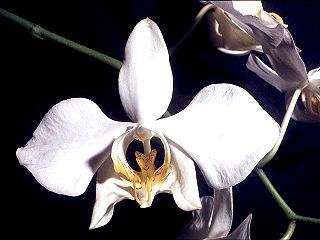
PhalaenopsisBlume (1825), commonly known as moth orchids, is a genus of about seventy species of plants in the family Orchidaceae. Orchids in this genus are monopodial epiphytes or lithophytes with long, coarse roots, short, leafy stems and long-lasting, flat flowers arranged in a flowering stem that often branches near the end. Orchids in this genus are native to India, Taiwan, China, Southeast Asia, New Guinea and Australia with the majority in Indonesia and the Philippines.
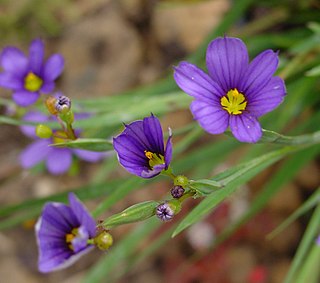
Sisyrinchium is a large genus of annual to perennial flowering plant in the family Iridaceae. Native to the New World, the species are known as blue-eyed grasses and, though not true grasses and in varieties with flower colors other than blue, are monocots.
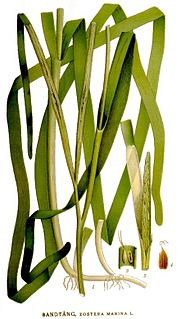
Zosteraceae is a family of marine perennial flowering plants found in temperate and subtropical coastal waters, with the highest diversity located around Korea and Japan. Most seagrasses complete their entire life cycle under water, having filamentous pollen especially adapted to dispersion in an aquatic environment and ribbon-like leaves that lack stomata. Seagrasses are herbaceous and have prominent creeping rhizomes. A distinctive characteristic of the family is the presence of characteristic retinacules, which are present in all species except members of Zostera subgenus Zostera.
Index Fungorum is an international project to index all formal names in the fungus kingdom. As of 2015 the project is based at the Royal Botanic Gardens, Kew, one of three partners along with Landcare Research and the Institute of Microbiology, Chinese Academy of Sciences.

Ruppia, also known as the widgeonweeds, ditch grasses or widgeon grass, is the only extant genus in the family Ruppiaceae, with eight known species. These are aquatic plants widespread over much of the world. The genus name honours Heinrich Bernhard Rupp, a German botanist (1688-1719). They are widespread outside of frigid zones and the tropics.
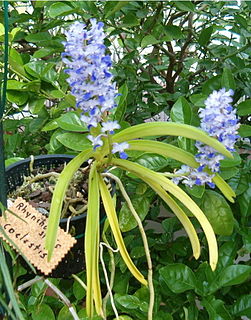
Rhynchostylis is a genus in the orchid family (Orchidaceae), closely allied to the genus Vanda and comprising four currently accepted species native to the Indian Subcontinent, China, Indochina, Malaysia, Indonesia and the Philippines. The name consists of a compound of two Greek elements : rhynchos 'beak' and stylis 'column' – in reference to the very broad, fleshy column of the flower. The flowers are borne in dense racemes and are noted for their intense, spicy fragrance. Although lacking in pseudobulbs, the plants have leathery leaves that are drought-resistant. These orchids grow naturally in warm, moist, shaded tropical areas and will thrive in cultivation if given consistent warmth, uniform moisture and bright, but indirect light. Hobbyists wanting to grow them will need a warm, humid growing environment with gentle air movement. They can be grown in pots, but are better grown in baskets, owing to the extreme fleshiness of their roots. Their unusually fragrant blooms often appear in the slightly cooler winter months.

Luisia, commonly known as velvet orchids or 钗子股属 , is a genus of epiphytic or lithophytic orchids in family Orchidaceae. Plants in this genus have flattened roots, long leafy stems, narrow, thick, leathery leaves and short-lived flowers that open sporadically. There are about forty species found from tropical and subtropical Asia to the Western Pacific.
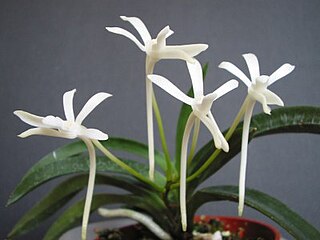
Neofinetia was a genus of flowering plants from the orchid family, Orchidaceae, that is now classified as a Vanda. It contained three species and was distributed in China, Korea, and Japan.
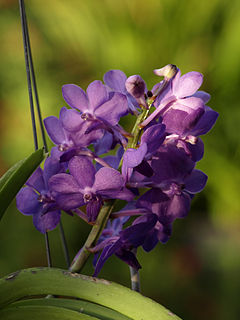
×Vandachostylis, abbreviated Van. in the horticultural trade, is the nothogenus for intergeneric hybrids between the orchid genera Rhynchostylis and Vanda. It is now the accepted name for several former hybrid genera, such as × Vascostylis and × Neostylis, since Ascocentrum and Neofinetia are now both synonymous with Vanda.

Kleinia petraea is a species of the genus Kleinia and family Asteraceae which was previously considered to be a species of Senecio. Native to Kenya and Tanzania, it is colloquially known as creeping jade, trailing jade or weeping jade due to its resemblance to the unrelated Jade plant. It is grown as a garden plant as a groundcover or in hanging baskets.

Rhynchostylis gigantea is a species of orchid. This species was first described in 1896 by John Lindley and occurs in Myanmar, Thailand, Malaysia, Laos, Cambodia, Vietnam, Hainan China, Borneo, Bangladesh, Northeast India and the Philippines.

Rhynchostylis coelestis is a species of orchid endemic to Indochina.

Euphronia is a genus of three species of shrubs native to northern South America and is the only genus in the family Euphroniaceae. It was previously classified in the Vochysiaceae family and elsewhere due to its unique floral features, but the APG III system of 2009 recognized Euphroniaceae as distinct and placed Euphronia in it. Based on molecular data from the rbcL gene, it is sister to the Chrysobalanaceae.

Protea sulphurea, also known as the sulphur sugarbush, is a flowering plant of the genus Protea in the family Proteaceae, which is only known to grow in the wild in the Western Cape province of South Africa. A vernacular name for the plant in the Afrikaans language is heuningkoeksuikerbos or Skaamblom.

Protea foliosa, also known as the leafy sugarbush, is a flowering plant of the genus Protea in the family Proteaceae which is endemic to the Cape Region of South Africa. In the Afrikaans language it is known as ruie-suikerbos.

Protea punctata, also known as the water sugarbush or water white sugarbush, is a shrub belonging to the genus Protea which is found growing in the wild in South Africa.

















